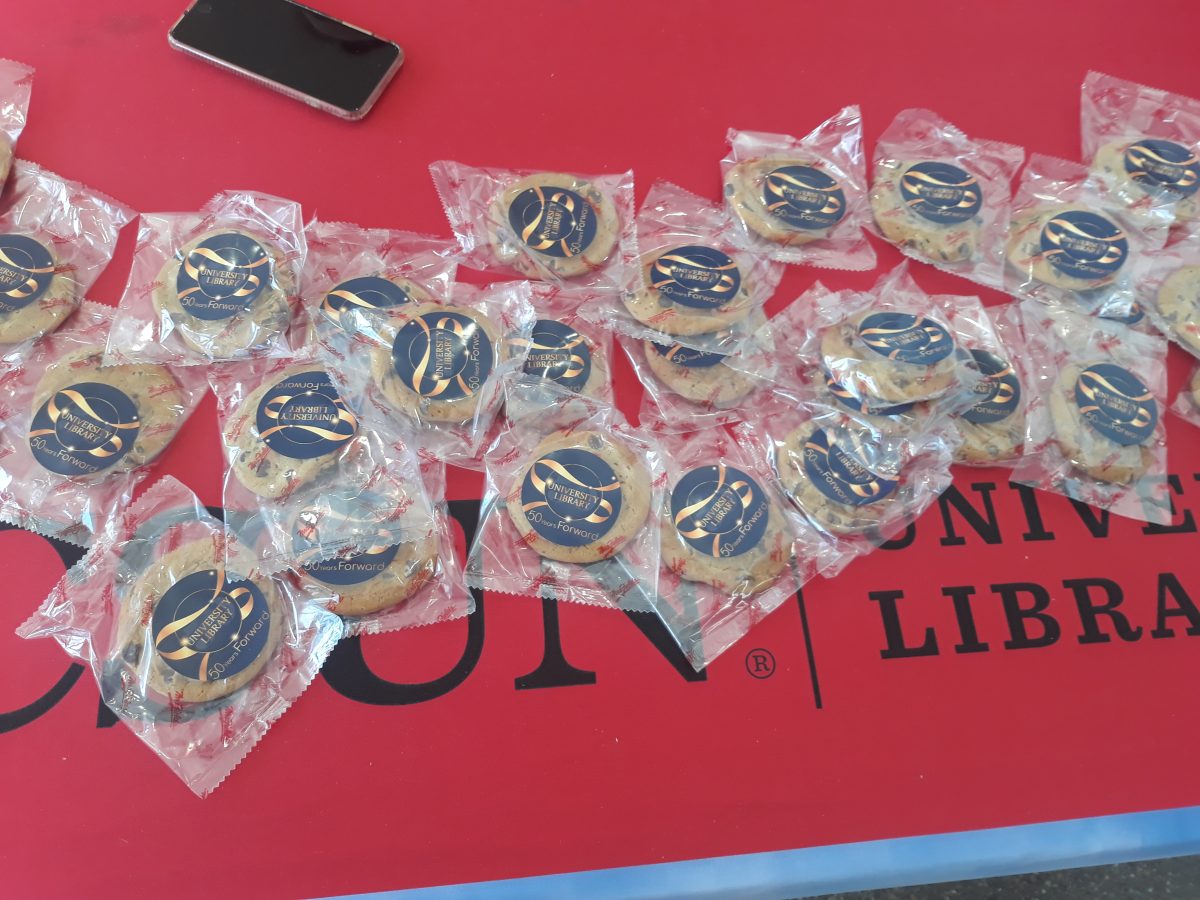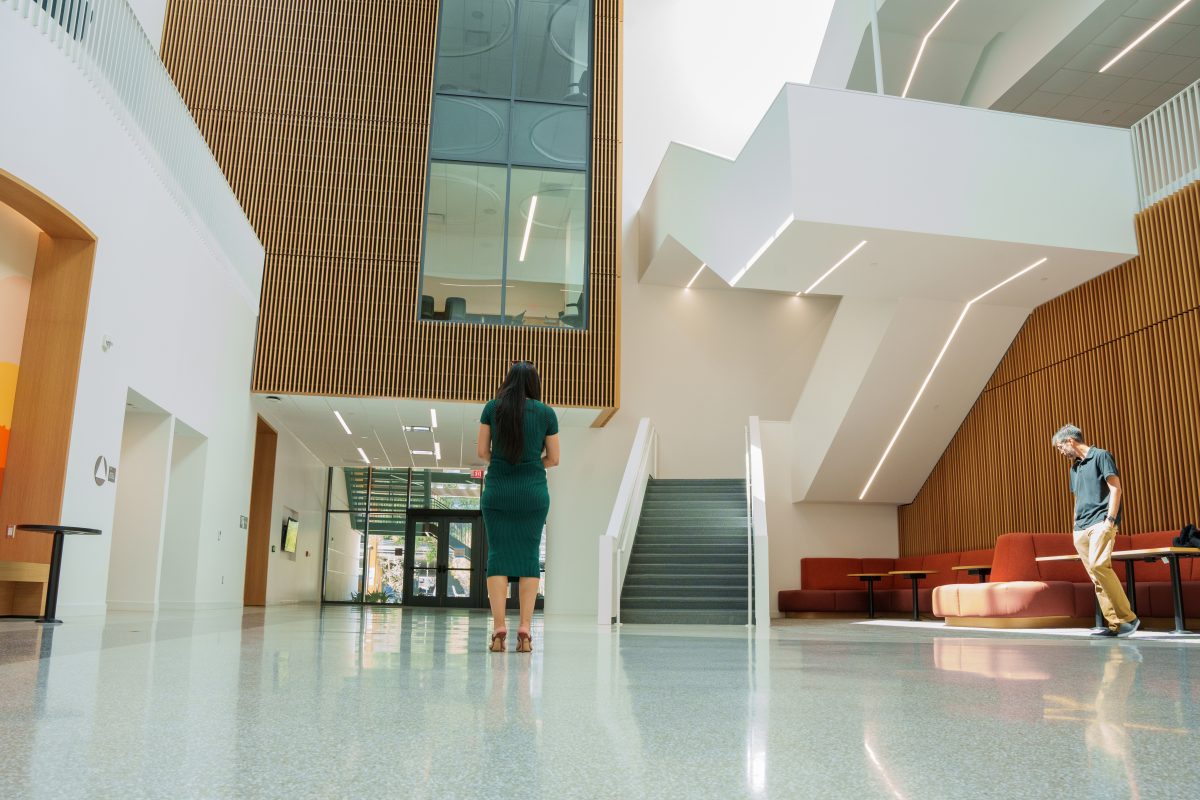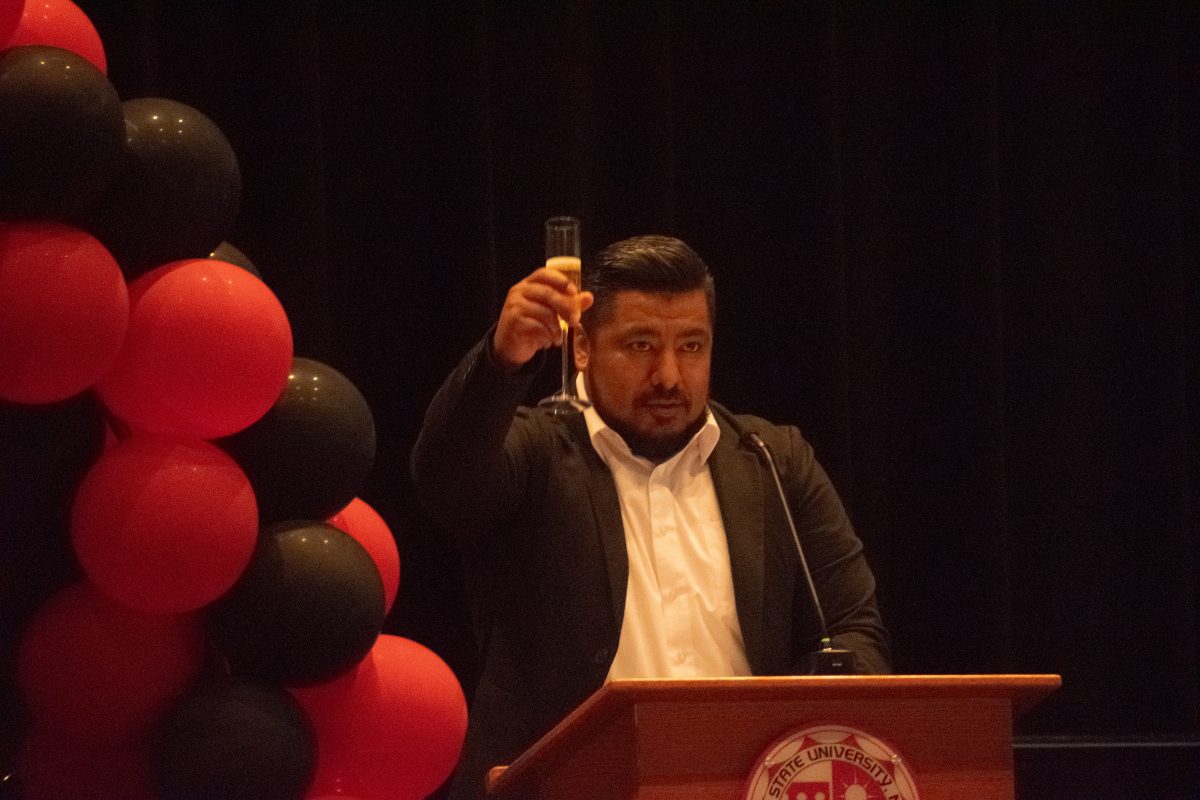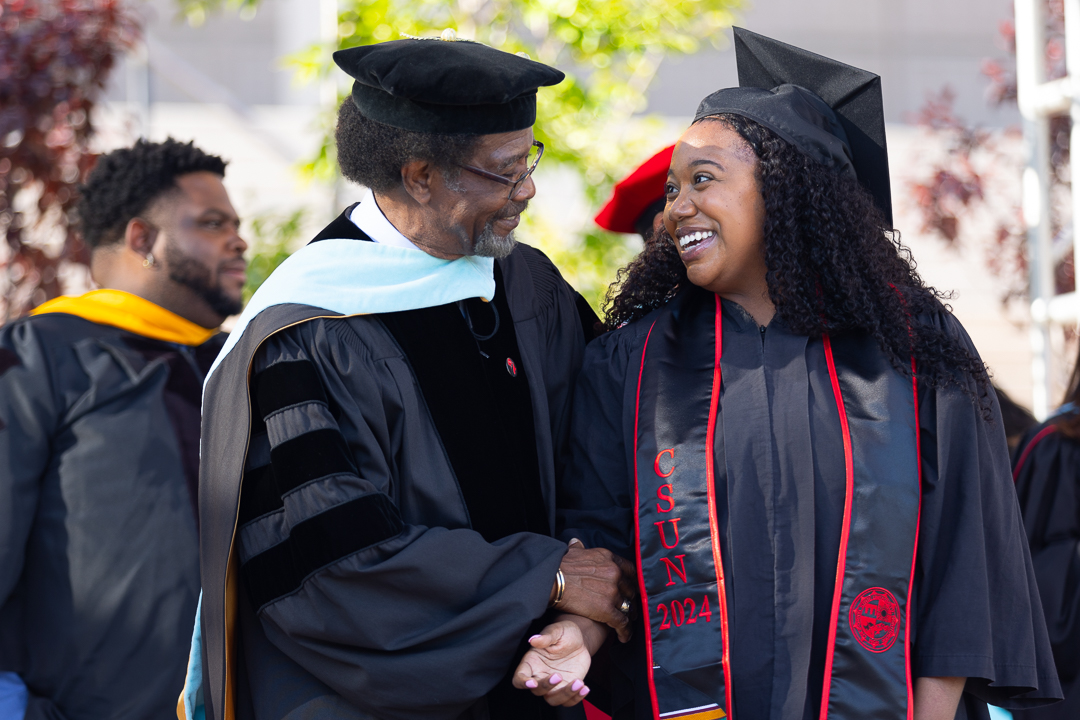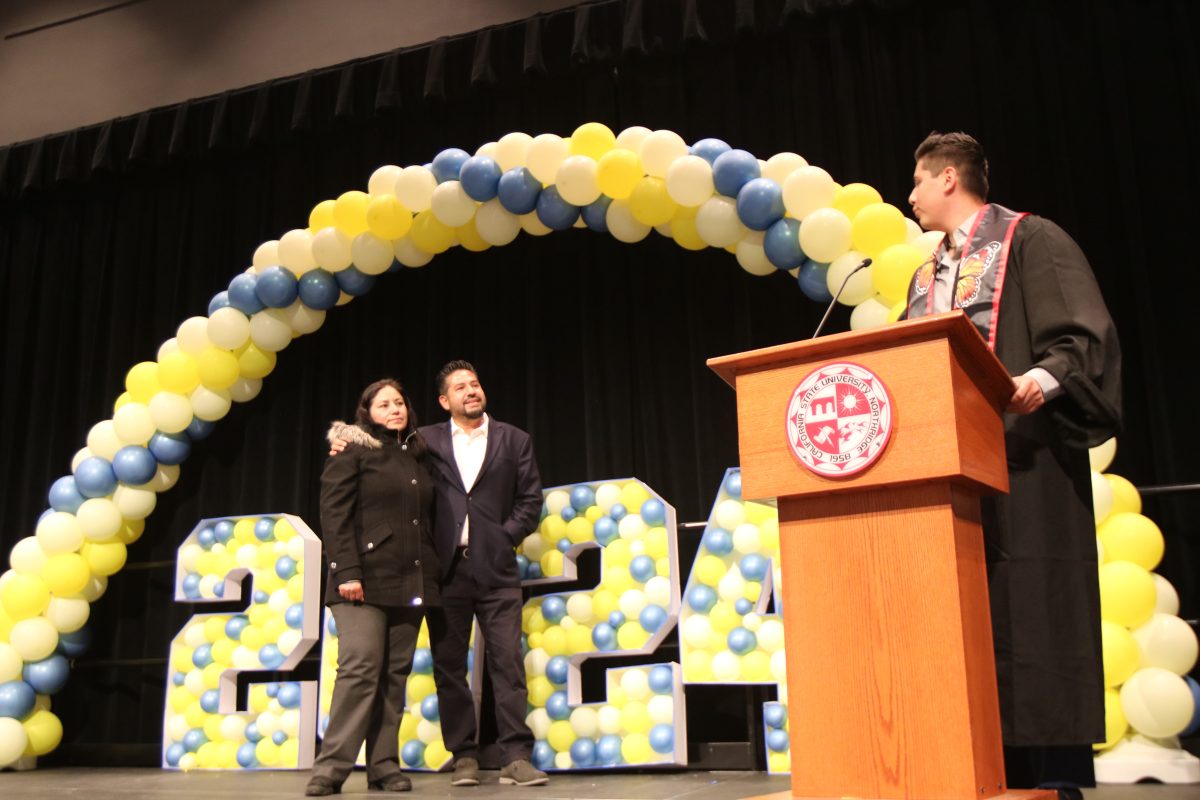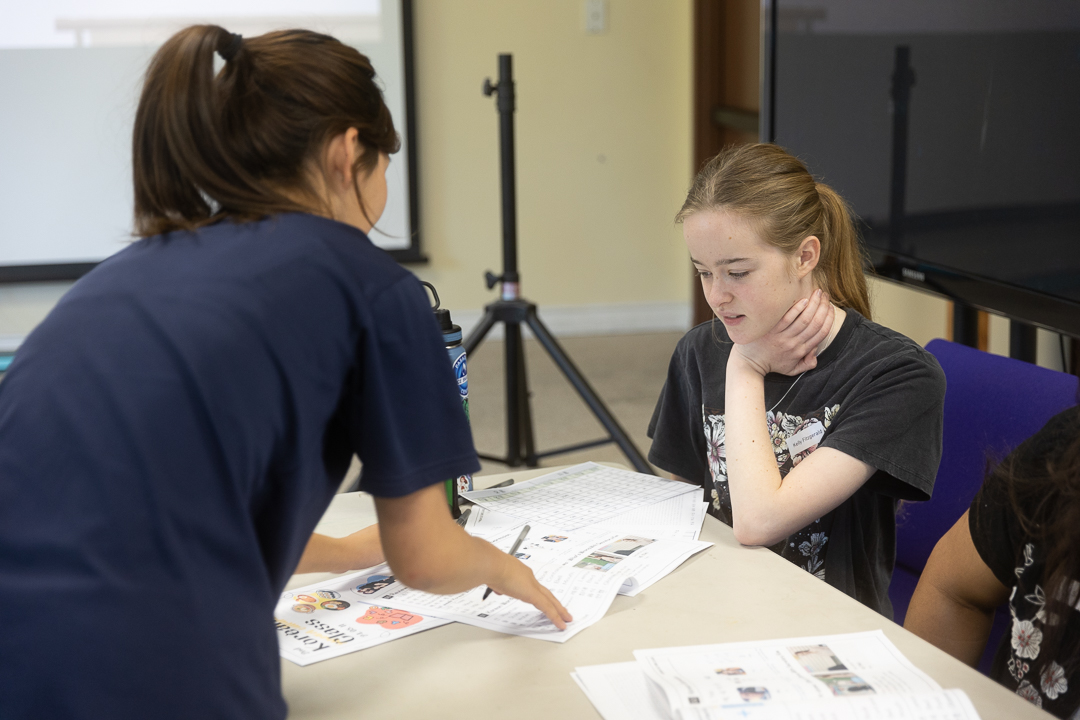CSUN’s University Library towers above other buildings on campus with four-story high columns that resemble those in ancient Greece. Its giant steps invite people from all over the university to check out its hundreds of thousands of volumes and utilize its many other resources. The library is positioned smack-dab in the middle of CSUN, and captures people’s attention as they walk through campus.
As students walked into the massive building on Oct. 24, Associate Dean Kathy Dabbour sat by the entrance, handing out free cookies baked by the company Mrs. Fields. Dabbour started working at the library back when she was a student in the late 70s.
“Even though I’m in this office all day, when I was handing out cookies, it reminded me of my days working at the reference desk, teaching classes,” said Dabbour. “Everyone’s coming in and they’re ‘Oh, Happy Birthday library,’ or ‘Happy anniversary library,’ or ‘Really, you’re giving me a cookie for free?’ I just think our students are incredible. I think they’re just so happy to be here.”
The library has giant steps leading up to a portico, a prominent element of architecture from ancient Greece, where columns support the ceiling above the entrance to the main floor. Dean Mark Stover, who has been working at the library for 12 years, said the grandeur of the library is one of his favorite things about it.
“I like a lot of things about the architecture of the library,” Stover said. “One of my favorite things is the floor to ceiling windows that we have on the North side of the library and some of the study rooms, where students really like to have natural light come in while they’re studying.”
Both Stover and Dabbour said the study rooms are the most used resource the library offers.
The library was born in the 1970s, when the original San Fernando Valley State Library stood on the same spot, though it no longer had enough room for all of its volumes. CSUN commissioned architect Leo A. Daly to build the new library, which he completed in 1973. The structure spanned nearly 140,000 square feet. Under Daly’s supervision, wings were later added to the library. By 1991, when the East and West wings were added, the library almost doubled in size to around 235,000 square feet.
Three years later, the infamous Northridge earthquake ravaged the city, and substantially damaged the core of the library. 90 percent of the items in the on-shelf collection fell to the ground , and the wings were damaged beyond repair and later had to be rebuilt.
The Sundial spoke to then CSUN President Blenda Wilson about the damage caused by the earthquake, and she said it appeared worse than it actually was.
“The wings were designed with the latest seismic technology. The way the building crunched at the two sides is seismically what it was supposed to do,” Wilson said. “So the engineers tell me that it would look worse to me and you than it really is. It functioned the way it should to make sure that the entire building wouldn’t come down. We know that it’s a very serious mess inside and we know that cosmetically it looks awful. But apparently, structurally the library is not in as bad of shape as it would look to us.”
At the start of the new millennium, the wings were rebuilt and reopened, which marked a new era for CSUN’s library.
By the year 2000, CSUN had spent about $60 million building, expanding, and repairing the facility.
The library’s most unique possession, according to both Stover and Dabbour, is its archives. They were acquired through donations, and some go back 100 years, including collections from the Community Relations Committee of the Jewish Federation Council of Greater Los Angeles.
Over the last decade, the library was upgraded many times as it became the learning space students came to recognize.
The Learning Commons were created in 2013, helping to facilitate research through the use of new technology. A year later, the Creative Maker Studio was added, giving students a space to record podcasts, check out equipment, and even 3-D print.
In 2018, the Special Collections & Archives were expanded to twice their previous size, and housed about 50,000 items. That same year, the Music & Media department in the library expanded to include the Teacher Curriculum Center, which mostly caters to the educational needs of K-12 students.
CSUN’s University Library Map Collection, which was established 60 years prior, was also upgraded in 2018-19. It now contains over 400,000 maps.
The most recent change people have come to associate with the library, however, is not a physical one. Rather, it’s the change of the building’s name from Oviatt Library to University Library that has been at the forefront of people’s attention.
The library was initially named after late dean Delmar Oviatt, who was widely regarded as a good listener and admired by those who worked with him. The Students of Color Coalition pushed the university to change the name after they discovered what they believed to be proof that Oviatt was a “racist and oppressive figure.”
In 2019, former CSUN president Dianne Harrison commissioned the Oviatt Library Advisory Working Group to investigate the allegations.
The group recommended the removal of the name from the CSUN library, pointing to what they believed to be inaction on the part of Oviatt at a time when racial turmoil was high. Allegedly, Oviatt put little effort into reaching out to students of color and talking to them about their needs, and didn’t push for the development of the Ethnic Studies program.
The group also cited Oviatt’s tendency to use the LAPD to deal with student protests, particularly on January 9, 1969, when student demonstrators were met with about 100 police officers dispersing the crowd. This happened after Oviatt received mixed accounts on whether the protests would be violent. And so the name was changed.
Throughout its history, the library has seen hundreds of thousands of students walk through its doors. Since the pandemic, Thethe number of people who actually go in each week has declined, since the pandemic. .
In 2019, according to data Dabbour shared with the Sundial, 46,060 people entered the library in week five of the fall semester, which was the most in any week through the first half of the fall. This semester, the high point was 38,072 people in week one. The high point of this semester was 38,072 people in week one.
Despite the reduction in the number of people who enter the library, Stover said the pandemic, similarly to the earthquake, expedited the process of moving resources online for students.
“I look at the pandemic metaphorically as kind of a really bad hurricane, but there was a rainbow that was there as well that we were able to utilize to help students,” Stover said.
As the library evolved, it also turned from a quiet zone to a place where collaborative studying is encouraged, though there are areas on the top floors where talking isn’t allowed.
The tiling of the landing above the grand steps was upgraded after the pandemic, and Stover said they plan to upgrade the evacuation system next. Dabbour said they also plan to install new study pods, and she would like to upgrade some of the old oak furniture, as well as add noise dampening equipment in the ceiling of the second floor.
“It’s all about the comfort for the students,” Dabbour said. “I mean, the staff areas, it’s like ‘eh, whatever, as long as the carpet is clean.’ But you want the students to walk in and say ‘Wow. This is an amazing library.’”
The Associate Dean says the library has a science-fictionesque look to it, especially on the inside, where its modern technology, such as its 3-d printers, serve as a stark contrast to the classic architecture on the outside. The library was featured in Justin Bieber’s music video “Intentions,” and played host to many movies and shows throughout the years, such as “Star Trek” and “Sky High.”
Dabbour’s happiest memory at the library was meeting her husband, who also worked there. He passed away in 2007, and the library staff did a memorial service for him. To Dabbour, working at the library is more than just about its resources.
“There was a memorial service for him. So many people came and showed support,” Dabbour said. “So for me, this has been like a family.”
Her goal is to make the students feel the same way.
